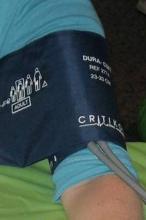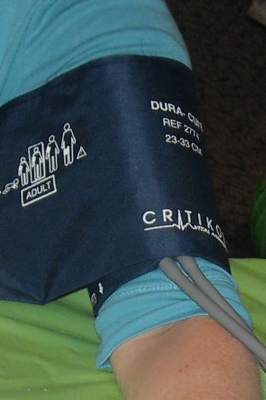User login
Systolic blood pressure begins a steady rise among men in their mid-40s, but that increase can be attenuated by physical fitness, to the extent that very fit men can stave off high systolic BP by a decade, compared with their unfit age-mates, according to a report published online Sept. 15 in the Journal of the American College of Cardiology.
Investigators performed a secondary analysis of data from the Aerobics Center Longitudinal Study to assess the trajectory of blood pressure over time and determine whether physical fitness, as measured by maximal treadmill exercise testing, influenced that trajectory. The ACLS was a large cohort study of healthy adults who underwent serial preventive medical assessments between 1970 and 2006, said Dr. Junxiu Liu of the department of epidemiology and biostatistics, University of South Carolina, Columbia, and her associates.
For their study, Dr. Liu and her colleagues focused on 13,953 men aged 20-90 years at baseline who participated in the ACLS, almost all of whom were white and 95% of whom were college-educated professionals. Overall, systolic blood pressure showed a linear increase with aging, while diastolic blood pressure did not. For each increase of 1 year in age, systolic BP increased by 0.30 mm Hg.
Systolic BP typically began to exceed 120 mm Hg at roughly age 46 years vin men with the lowest level of physical fitness but did not do so until age 54 years in those with the highest level of physical fitness. This suggests that engaging in physical activity reduces the duration of elevated systolic BP, which in turn may reduce the risk of developing cardiovascular disease, other hypertension-related chronic diseases, medical costs, major morbidity, and mortality, the investigators said (J. Am. Coll. Cardiol. 2014;64:1245-53 [doi:10.1016/j.jacc.2014.06.1184]).
In an analysis that accounted for numerous factors, age, body fat percent, waist circumference, resting heart rate, fasting glucose level, triglyceride level, cholesterol level, alcohol consumption status, and parental history of hypertension were all positively associated with systolic BP.
The major new finding from this study is that men who were in the highest fitness category demonstrated lower systolic blood pressure throughout the adult life span, compared with men who had moderate and low fitness levels. This difference could not be explained by differences in body fatness, waist circumference, lipid profiles, smoking status, alcohol intake, or other factors related to blood pressure, which were statistically controlled for. Indeed, habitual aerobic exercise/physical activity may even counteract the burden of cardiometabolic abnormalities that accelerate artery stiffening and therefore slow the onset and severity of isolated systolic hypertension. Dr. Stanley S. Franklin is in the heart disease prevention program at the University of California, Irvine. Gary L. Pierce, Ph.D., is in the department of health and human physiology at the University of Iowa, Iowa City. They made these remarks in an editorial accompanying Dr. Liu’s report (J. Am. Coll. Cardiol. 2014;1254-6 [doi:10.1016;j.jacc.2014.06.1183]). Dr. Franklin and Dr. Pierce reported no financial conflicts of interest.
The major new finding from this study is that men who were in the highest fitness category demonstrated lower systolic blood pressure throughout the adult life span, compared with men who had moderate and low fitness levels. This difference could not be explained by differences in body fatness, waist circumference, lipid profiles, smoking status, alcohol intake, or other factors related to blood pressure, which were statistically controlled for. Indeed, habitual aerobic exercise/physical activity may even counteract the burden of cardiometabolic abnormalities that accelerate artery stiffening and therefore slow the onset and severity of isolated systolic hypertension. Dr. Stanley S. Franklin is in the heart disease prevention program at the University of California, Irvine. Gary L. Pierce, Ph.D., is in the department of health and human physiology at the University of Iowa, Iowa City. They made these remarks in an editorial accompanying Dr. Liu’s report (J. Am. Coll. Cardiol. 2014;1254-6 [doi:10.1016;j.jacc.2014.06.1183]). Dr. Franklin and Dr. Pierce reported no financial conflicts of interest.
The major new finding from this study is that men who were in the highest fitness category demonstrated lower systolic blood pressure throughout the adult life span, compared with men who had moderate and low fitness levels. This difference could not be explained by differences in body fatness, waist circumference, lipid profiles, smoking status, alcohol intake, or other factors related to blood pressure, which were statistically controlled for. Indeed, habitual aerobic exercise/physical activity may even counteract the burden of cardiometabolic abnormalities that accelerate artery stiffening and therefore slow the onset and severity of isolated systolic hypertension. Dr. Stanley S. Franklin is in the heart disease prevention program at the University of California, Irvine. Gary L. Pierce, Ph.D., is in the department of health and human physiology at the University of Iowa, Iowa City. They made these remarks in an editorial accompanying Dr. Liu’s report (J. Am. Coll. Cardiol. 2014;1254-6 [doi:10.1016;j.jacc.2014.06.1183]). Dr. Franklin and Dr. Pierce reported no financial conflicts of interest.
Systolic blood pressure begins a steady rise among men in their mid-40s, but that increase can be attenuated by physical fitness, to the extent that very fit men can stave off high systolic BP by a decade, compared with their unfit age-mates, according to a report published online Sept. 15 in the Journal of the American College of Cardiology.
Investigators performed a secondary analysis of data from the Aerobics Center Longitudinal Study to assess the trajectory of blood pressure over time and determine whether physical fitness, as measured by maximal treadmill exercise testing, influenced that trajectory. The ACLS was a large cohort study of healthy adults who underwent serial preventive medical assessments between 1970 and 2006, said Dr. Junxiu Liu of the department of epidemiology and biostatistics, University of South Carolina, Columbia, and her associates.
For their study, Dr. Liu and her colleagues focused on 13,953 men aged 20-90 years at baseline who participated in the ACLS, almost all of whom were white and 95% of whom were college-educated professionals. Overall, systolic blood pressure showed a linear increase with aging, while diastolic blood pressure did not. For each increase of 1 year in age, systolic BP increased by 0.30 mm Hg.
Systolic BP typically began to exceed 120 mm Hg at roughly age 46 years vin men with the lowest level of physical fitness but did not do so until age 54 years in those with the highest level of physical fitness. This suggests that engaging in physical activity reduces the duration of elevated systolic BP, which in turn may reduce the risk of developing cardiovascular disease, other hypertension-related chronic diseases, medical costs, major morbidity, and mortality, the investigators said (J. Am. Coll. Cardiol. 2014;64:1245-53 [doi:10.1016/j.jacc.2014.06.1184]).
In an analysis that accounted for numerous factors, age, body fat percent, waist circumference, resting heart rate, fasting glucose level, triglyceride level, cholesterol level, alcohol consumption status, and parental history of hypertension were all positively associated with systolic BP.
Systolic blood pressure begins a steady rise among men in their mid-40s, but that increase can be attenuated by physical fitness, to the extent that very fit men can stave off high systolic BP by a decade, compared with their unfit age-mates, according to a report published online Sept. 15 in the Journal of the American College of Cardiology.
Investigators performed a secondary analysis of data from the Aerobics Center Longitudinal Study to assess the trajectory of blood pressure over time and determine whether physical fitness, as measured by maximal treadmill exercise testing, influenced that trajectory. The ACLS was a large cohort study of healthy adults who underwent serial preventive medical assessments between 1970 and 2006, said Dr. Junxiu Liu of the department of epidemiology and biostatistics, University of South Carolina, Columbia, and her associates.
For their study, Dr. Liu and her colleagues focused on 13,953 men aged 20-90 years at baseline who participated in the ACLS, almost all of whom were white and 95% of whom were college-educated professionals. Overall, systolic blood pressure showed a linear increase with aging, while diastolic blood pressure did not. For each increase of 1 year in age, systolic BP increased by 0.30 mm Hg.
Systolic BP typically began to exceed 120 mm Hg at roughly age 46 years vin men with the lowest level of physical fitness but did not do so until age 54 years in those with the highest level of physical fitness. This suggests that engaging in physical activity reduces the duration of elevated systolic BP, which in turn may reduce the risk of developing cardiovascular disease, other hypertension-related chronic diseases, medical costs, major morbidity, and mortality, the investigators said (J. Am. Coll. Cardiol. 2014;64:1245-53 [doi:10.1016/j.jacc.2014.06.1184]).
In an analysis that accounted for numerous factors, age, body fat percent, waist circumference, resting heart rate, fasting glucose level, triglyceride level, cholesterol level, alcohol consumption status, and parental history of hypertension were all positively associated with systolic BP.
FROM THE JOURNAL OF THE AMERICAN COLLEGE OF CARDIOLOGY
Key clinical point: Physically fit men may postpone the inevitable rise of systolic blood pressure by 10 years.
Major finding: Systolic BP typically began to exceed 120 mm Hg at approximately age 46 years among men with the lowest level of physical fitness but did not do so until age 54 years among men with the highest level of physical fitness.
Data source: A secondary analysis of data from a longitudinal cohort study, involving 13,953 men aged 20-90 years at baseline who underwent serial medical assessments between 1970 and 2006.
Disclosures: This study was supported by the National Institutes of Health. Dr. Liu reported no financial conflicts of interest; an associate reported ties to Technogym, Santech, Clarity, Coca-Cola, and BodyMedia.

